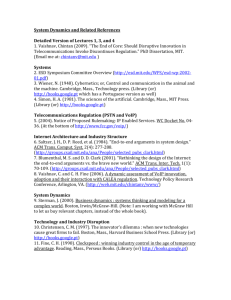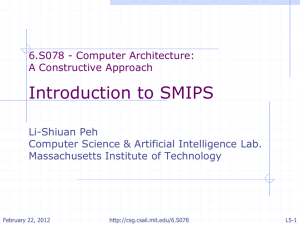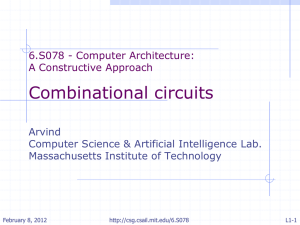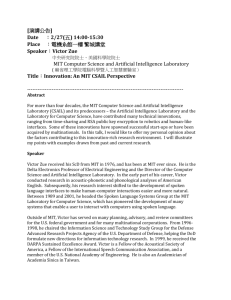Arithmetic-Logic Unit (ALU) Combinational ALU
advertisement
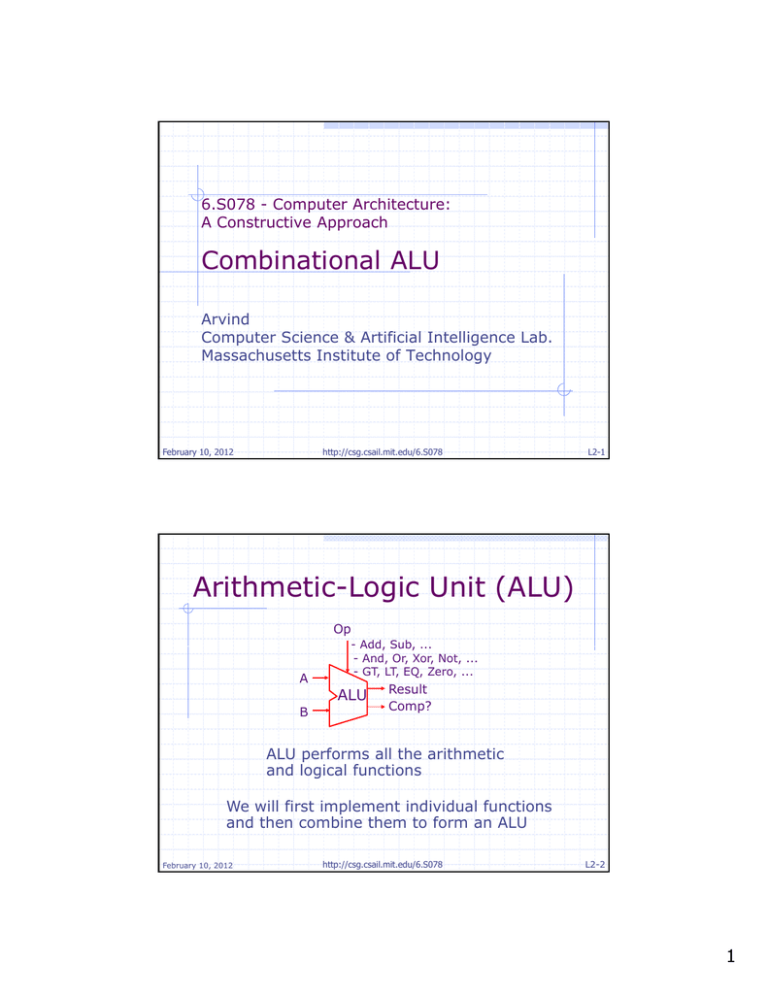
6.S078 - Computer Architecture:
A Constructive Approach
Combinational ALU
Arvind
Computer Science & Artificial Intelligence Lab.
Massachusetts Institute of Technology
February 10, 2012
http://csg.csail.mit.edu/6.S078
L2-1
Arithmetic-Logic Unit (ALU)
Op
A
- Add,
Add Sub
Sub, ...
- And, Or, Xor, Not, ...
- GT, LT, EQ, Zero, ...
ALU
B
Result
Comp?
ALU performs all the arithmetic
and logical functions
We will first implement individual functions
and then combine them to form an ALU
February 10, 2012
http://csg.csail.mit.edu/6.S078
L2-2
1
A w-bit Ripple-Carry Adder
function Bit#(TAdd#(w,1)) addN(Bit#(w) x, Bit#(w) y,
Bit#(1) c0);
Bit#(w) s; Bit#(TAdd#(w,1)) c; c[0] = c0;
let valw = valueOf(w);
for(Integer i=0; i<valw; i=i+1)
begin
let cs = fa(x[i],y[i],c[i]);
c[i+1] = cs[1]; s[i] = cs[0];
end
return {c[valw],s};
endfunction
Structural interpretation of a loop – unfold it to
generate an acyclic graph
February 10, 2012
http://csg.csail.mit.edu/6.S078
L2-3
Integer versus Int#(32)
In mathematics integers are unbounded but in
computer
systems
integers
always
p
y
g
y have a
fixed size
Bluespec allows us to express both types of
integers, though unbounded integers are used
only as a programming convenience
for(Integer i=0; i<valw; i=i+1)
begin
let cs = fa(x[i],y[i],c[i]);
c[i+1] = cs[1]; s[i] = cs[0];
end
February 10, 2012
http://csg.csail.mit.edu/6.S078
L2-4
2
Static Elaboration phase
When Bluespec program are compiled, first
type
yp checking
g is done and then the compiler
p
gets rid of many constructs which have no
direct hardware meaning, like Integers, loops
for(Integer i=0; i<valw; i=i+1) begin
let cs = fa(x[i],y[i],c[i]);
c[i+1] = cs[1]; s[i] = cs[0];
end
cs0 = fa(x[0], y[0], c[0]); c[1]=cs0[1]; s[0]=cs0[0];
cs1 = fa(x[1], y[1], c[1]); c[2]=cs1[1]; s[1]=cs1[0];
…
csw = fa(x[valw-1], y[valw-1], c[valw-1]);
c[valw] = csw[1]; s[valw-1] = csw[0];
February 10, 2012
http://csg.csail.mit.edu/6.S078
L2-5
Logical right shift by 2
abcd
0 0
00ab
Fixed size shift operation is cheap in hardware
– just wire the circuit appropriately
Rotate,
Rotate sign-extended shifts – all are equally
easy
February 10, 2012
http://csg.csail.mit.edu/6.S078
L2-6
3
Conditional operation:
shift versus no-shift
0 0
s
We need a Mux to select the appropriate wires: if
s is one the Mux will select the wires on the left
otherwise it would select wires on the right
(s==0)?{a,b,c,d}:{0,0,a,b};
L2-7
http://csg.csail.mit.edu/6.S078
February 10, 2012
A 2-way multiplexer
A
A
AND
OR
B
S
B
AND
S
(s==0)?A:B
(
)
February 10, 2012
Gate-level
Gate
level implementation
http://csg.csail.mit.edu/6.S078
L2-8
4
A 4-way multiplexer
A
case {s1,s0} matches
0: A;
1: B;
2: C;
3: D;
endcase
B
S0
C
S1
D
S0
February 10, 2012
L2-9
http://csg.csail.mit.edu/6.S078
Logical right shift by n
Shift n can be broken down in
several steps
p of fixed-length
g shifts
of 1, 2, 4, …
Thus a shift of size 3 can be
s1
performed by first doing a shift of
length 2 and then a shift of length 1
We need a Mux to select whether s0
we need to shift at all
00
0
The whole structure can be expressed
an a bunch of nested conditional
expressions
You will write a Blusepec program to produce a
variable size shifter in Lab 1
February 10, 2012
http://csg.csail.mit.edu/6.S078
L2-10
5
Type synonyms
typedef Bit [7:0] Byte;
typedef Bit#(8) Byte;
typedef Bit [31:0] Word;
typedef Tuple2#(a,a) Pair#(type a);
typedef Int#(n) MyInt#(type n);
typedef Int#(n) MyInt#(numeric type n);
February 10, 2012
http://csg.csail.mit.edu/6.S078
L2-11
Enumerated types
typedef enum {Red, Blue, Green}
Color deriving(Bits, Eq);
typedef enum {Eq, Neq, Le, Lt, Ge, Gt}
BrType deriving(Bits, Eq);
typedef enum {Add, Sub, And, Or, Xor, Nor, Slt, Sltu,
LShift, RShift, Sra}
AluFunc deriving(Bits, Eq);
January 18, 2012
http://csg.csail.mit.edu/SNU
L7-12
6
Structure type
Example: Complex Addition
typedef struct{
Int#(t) r;
Int#(t) i;
} Complex#(numeric type t) deriving (Eq,Bits);
function Complex#(t) \+
(Complex#(t) x, Complex#(t) y);
Int#(t) real = x.r + y.r;
Int#(t) imag = x.i + y.i;
return(Complex{r:real, i:imag});
endfunction
January 12, 2012
http://csg.csail.mit.edu/SNU
L4-13
Combinational ALU
function Bit#(width) alu(Bit#(width) a,
Bit#(width) b, AluFunc op);
Bit#(width) res = case(op)
Add
: add(a, b);
Sub
: subtract(a, b);
And
: (a & b);
Or
: (a | b);
Xor
: (a ^ b);
Nor
: ~(a | b);
Slt
: setLessThan(a, b);
Sltu : setLessThanUnsigned(a, b);
LShift: logicalShiftLeft(a, b[4:0]);
RShift: logicalShiftRight(a, b[4:0]);
Sra
: signedShiftRight(a, b[4:0]);
endcase;
return res;
endfunction
February 10, 2012
http://csg.csail.mit.edu/6.S078
L2-14
7
Comparison operators
function Bool aluBr(Bit#(width) a,
Bit#(width) b, BrType brOp);
Bool brTaken = case(brOp)
Eq
: (a == b);
Neq : (a != b);
Le
: signedLE(a, 0);
Lt
: signedLT(a, 0);
Ge
: signedGE(a, 0);
Gt
: signedGT(a, 0);
endcase;
return brTaken;
endfunction
L2-15
http://csg.csail.mit.edu/6.S078
February 10, 2012
ALU including Comparison
operators
b
a
…
Eq
LShift
…
Add
op
mux
February 10, 2012
mux
http://csg.csail.mit.edu/6.S078
brOp
L2-16
8
Complex combinational
circuits
February 10, 2012
http://csg.csail.mit.edu/6.S078
L2-17
Multiplication by repeated
addition
b Multiplicand 1101
a Muliplier
p
* 1011
1101
+
1101
+ 0000
+ 1101
10001111
a0
(13)
((11))
a1
m0
m1
0
add4
(143)
a2
m2
add4
a3
m3
mi = (a[i]==0)? 0 : b;
add4
February 10, 2012
http://csg.csail.mit.edu/6.S078
L2-18
9
Combinational 32-bit multiply
function Bit#(64) mul32(Bit#(32) a, Bit#(32) b);
Bit#(32) prod = 0;
Bit#(32) tp
t = 0;
0
for(Integer i = 0; i < 32; i = i+1)
begin
Bit#(32) m = (a[i]==0)? 0 : b;
Bit#(33) sum = add32(m,tp,0);
prod[i] = sum[0];
tp = truncateLSB(sum);
end
return {tp,prod};
endfunction
February 10, 2012
http://csg.csail.mit.edu/6.S078
L2-19
Combinational n-bit multiply
function Bit#(TAdd#(w,w)) mulN(Bit#(w) a, Bit#(w) b);
Bit#(w) prod = 0;
Bit#( ) tp
Bit#(w)
t = 0;
0
for(Integer i = 0; i < valueOf(w); i = i+1)
begin
Bit#(w) m = (a[i]==0)? 0 : b;
Bit#(TAdd#(w,1)) sum = addN(m,tp,0);
prod[i] = sum[0];
tp = truncateLSB(sum);
end
return {tp,prod};
endfunction
February 10, 2012
http://csg.csail.mit.edu/6.S078
L2-20
10
Design issues with
combinational multiply
Lot of hardware
32-bit multiply uses 31 addN circuits
Long chains of gates
32-bit ripple carry adder has a 31 long
chain of gates
32-bit multiply has 31 ripple carry adders in
sequence!
The speed of a combinational circuit is
determined by its longest input-to-output
path
next time: Sequential circuits
February 10, 2012
http://csg.csail.mit.edu/6.S078
L2-21
11

